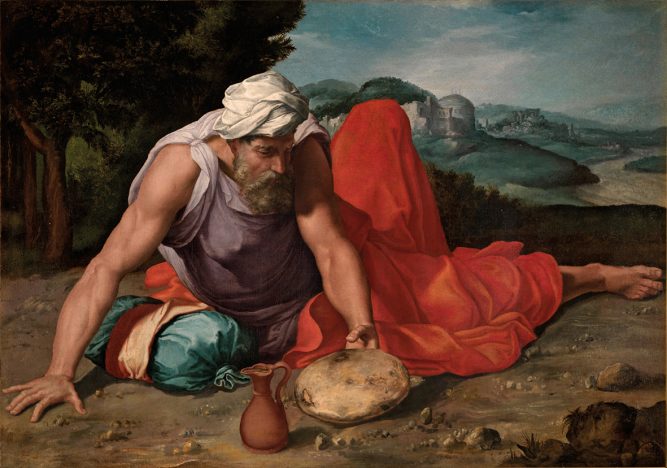The Uffizi’s New Acquisition

The Uffizi recently purchased Daniele Ricciarelli’s (the artist better known as Daniele da Volterra) Elijah in the Desert. The painting was completed between 1543-1547, under the papacy of Paul II Farnese. A masterpiece of 16th century Italian painting, the work depicts the prophet Elijah in a moment of meditation.
The influence of Michelangelo’s monumental figures in the Sistine Chapel is evident in Elijah’s musculature and pose, as well as the work’s rich tonality. Knee bent upwards, bearded head downturned, Elijah’s body stretches across the canvas: a commanding presence. Skin luminous, the prophet reaches for the miraculous loaf of bread with a brawny arm. A landscape rendered in jewel-toned teals and greens peeks out from behind the reclining figure. Elijah’s scarlet cloth and mauve tunic grounds the otherwise earthen-hued composition. The aqua pouch by his hip recalling the blues of the background landscape: a harmonious composition in both form and color.
This is not the first time that Elijah in the Desert has been on public display. The painting was the centerpiece of the 2003-2004 exhibition Daniele da Volterra: The Paintings of Elci at Casa Buonarroti in Florence. Most recently, Elijah in the Desert was featured in the exhibition Daniele da Volterra: The Paintings of Elci at the Galleria Nazionale d’Arte Antica in Rome, and this year’s show Eternity and Time between Michelangelo and Caravaggio in Cervia.
An important piece, Eike Schmidt, director of the Uffizi, stated that the purchase could not have come at a more opportune time. Previously in the private collection of the Pannocchieschi d’Elci family, the painting will now be placed in the Uffizi’s newly inaugurated Michelangelo hall: a series of spaces dedicated to 16th century paintings. Schmidt stated on the July 18 presentation that the lustrous painting will hang next to Ricciarelli’s 1557 Massacre of the Innocents. (isabelle blank)
